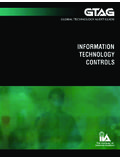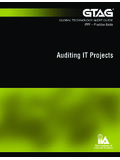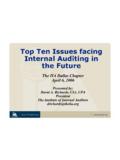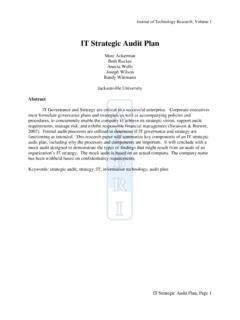Transcription of GTAG 1: Information Technology Controls - IIA …
1 Information Technology Controls A uditing Application Controls Authors David A. Richards, CIA, President, The IIA. Alan S. Oliphant, MIIA, QiCA, MAIR International Christine Bellino, Jefferson Wells Charles H. Le Grand, CIA, CHL Global Steve Hunt, Enterprise Controls Consulting LP. July 200 March 20057. Copyright 20057 by The Institute of Internal Auditors (IIA), 247 Maitland Ave., Altamonte Springs, FL 32701-4201 USA. All rights reserved. Printed in the United States of America. No part of this publication may be reproduced, stored in a retrieval system, or transmitted in any form by any means electronic, mechanical, photocopying, recording, or otherwise without prior written permission from the publisher. The IIA publishes this document for informational and educational purposes. This document is intended to provide Information , but is not a substitute for legal or accounting advice.
2 The IIA does not provide such advice and makes no warranty as to any legal or accounting results through its publication of this document. When legal or accounting issues arise, professional assistance should be sought and retained. gtag Table of Contents: Section 1 Section 19. Letter from the President ..ii Appendix H CAE Checklist ..423. Section 2 Section 20. IT Controls Executive Summary ..iii Appendix I References ..445. Section 3 Section 21. Introduction ..1 Appendix J Glossary ..467. Section 4 Section 22. Assessing IT Controls An Overview ..2 Appendix K About the Global Technology Audit Guides ..489. Section 5. Understanding IT Controls ..3 Section 23. Appendix L gtag Partners and Section 6 Global Project Team ..4950. Importance of IT Controls ..10. Section 7. IT Roles in the Organization ..11. Section 8. Analyzing Section 9. Monitoring and Techniques.
3 18. Section 10. Assessment ..20. Section 11. Conclusion ..22. Section 12. Appendix A Information Security Program Section 13. Appendix B Compliance With Laws and Regulations ..24. Section 14. Appendix C Three Categories of IT Knowledge for Internal Auditors ..28. Section 15. Appendix D Compliance Frameworks ..29. Section 16. Appendix E - Assessing IT Controls Using COSO ..356. Section 17. Appendix F - ITGI control Objectives for Information and Related Technology (CobiT) ..378. Section 18. Appendix G Example IT control Metrics to Be Considered by Audit Committees ..3940. i gtag Letter from the President 1. In my previous role as a chief audit executive (CAE), I noted a need for guidance on IT management and control written specifically for executives. So one of my first acts as president of The IIA was to initiate a project to produce this IT.
4 Controls guide. This guide is for the executive, not the technical staff although it will help those personnel better relate to management and governance perspectives. The purpose of this document is to explain IT Controls and audit practice in a format that allows CAEs to understand and communicate the need for strong IT Controls . It is organized to enable the reader to move through the framework for assess- ing IT Controls and to address specific topics based on need. This document provides an overview of the key components of IT control assessment with an emphasis on the roles and responsibilities of key constituents within the organization who can drive governance of IT resources. You may already be familiar with some aspects of this document, while other segments will provide new perspectives on how to approach this key audit strategy.
5 It is our hope that the components can be used to edu- cate others about what IT Controls are and why management and internal auditing must ensure proper attention is paid to this fundamental methodology for good governance. Although Technology provides opportunities for growth and development, it also provides the means and tools for threats such as disruption, deception, theft, and fraud. Outside attackers threaten our organizations, yet trusted insiders are a far greater threat. Fortunately, Technology can also provide protection from threats, as you will see in this guide. Executives should know the right questions to ask and what the answers mean. For example: Why should I understand IT Controls ? One word: Assurance. Executives play a key role in assuring Information reliability. Assurance comes primarily from an interdependent set of business Controls , plus the evidence that Controls are continuous and sufficient.
6 Management and governance must weigh the evidence provided by Controls and audits and conclude that it provides reasonable assurance. This guide will help you understand the evidence. What is to be protected? Let's start with trust. Trust enables business and efficiency. Controls provide the basis for trust, although they are often unseen. Technology provides the foundation for many perhaps most business Controls . Reliability of financial Information and processes now mandated for many companies is all about trust. Where are IT Controls applied? Everywhere. IT includes Technology components, processes, people, organization, and architecture collectively known as infrastructure as well as the Information itself. Many of the infrastructure Controls are technical, and IT supplies the tools for many business Controls . Who is responsible? Everybody.
7 But you must specify control ownership and responsibilities, otherwise no one is respon- sible. This guide addresses specific responsibilities for IT Controls . When do we assess IT Controls ? Always. IT is a rapidly changing environment, fueling business change. New risks emerge at a rapid pace. Controls must present continuous evidence of their effectiveness, and that evidence must be assessed and evaluated constantly. How much control is enough? You must decide. Controls are not the objective; Controls exist to help meet business objectives. Controls are a cost of doing business and can be expensive but not nearly as expensive as the probable consequences of inadequate Controls . IT Controls are essential to protect assets, customers, and partners, and sensitive Information ; demonstrate safe, efficient, and ethical behavior; and preserve brand, reputation, and trust.
8 In today's global market and regulatory environment, these are all too easy to lose. Use this guide as a foundation to assess or build your organization's framework and audit practices for IT business control , compliance, and assurance. Use it to help make sense of the conflicting advice you receive. Make sure all the elements are in place to meet the challenges of constant change, increasing complexity, rapidly evolving threats, and the need to improve efficiency constantly. The IIA produced this guide, but it is truly a team effort. The principal writers are Charles H. Le Grand, of CHL Global, and Alan S. Oliphant, FIIA, MIIA, QiCA, of Mair International. We owe a great debt of gratitude to our partners, IIA inter- national affiliates, and members of the Global Technology Audit Guide ( gtag ) team. We are grateful for their support and encouragement.
9 This guide is a testimony to what The IIA does best: Progress Through Sharing.. Sincerely, David A. Richards, CIA, CPA. President, The Institute of Internal Auditors, Inc. ii gtag Executive Summary 2. gtag Information Technology Controls describes the knowl- You don't need to everything about IT Controls , but edge needed by members of governing bodies, executives, IT remember two key control concepts: professionals, and internal auditors to address Technology Assurance must be provided by the IT Controls control issues and their impact on business. Other profes- within the system of internal Controls . This assurance sionals may find the guidance useful and relevant. The guide must be continuous and provide a reliable and provides Information on available frameworks for assessing continuous trail of evidence. IT Controls and describes how to establish the right frame- The auditor's assurance is an independent and work for an organization.
10 Moreover, it sets the stage for objective assessment of the first assurance. Auditor future GTAGs that will cover specific IT topics and associ- assurance is based on understanding, examining, and ated business roles and responsibilities in greater detail. assessing the key Controls related to the risks they The objectives of the IT Controls guide are to: manage, and performing sufficient testing to ensure Explain IT Controls from an executive perspective. the Controls are designed appropriately and function- Explain the importance of IT Controls within the ing effectively and continuously. overall system of internal Controls . Many frameworks exist for categorizing IT Controls and their Describe the organizational roles and responsibilities objectives. This guide recommends that each organization for ensuring IT Controls are addressed adequately use the applicable components of existing frameworks to within the overall system of internal Controls .




